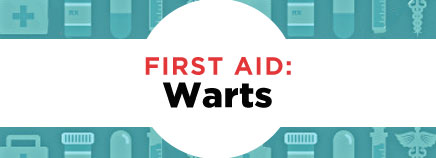
Warts are common skin infections that can affect any area of the body, but tend to occur on the fingers, hands, elbows, and bottom of the feet. Warts generally don’t cause serious problems, so they may not need to be removed.
There are several types of warts, including common warts, flat warts, and plantar warts.
Signs and Symptoms
Of a common wart include:
- located on back of hands, around nails, and in the mouth, or at the site of cuts and scratches
- a small flesh-colored bump
- a rough surface that looks like cauliflower
- pink or white soft bumps in the mouth
- tiny black dots inside the wart
Of a flat wart include:
- located on the face, neck, arms, or legs
- small smooth bumps with a flat top
- flesh-colored or pink to light brown
- may occur in groups of 20 to 100
Of a plantar wart include:
- located on the sole of the foot
- pressed into the skin
- tiny black dots inside
- may be painful
What to Do
Without treatment, it can take anywhere from 6 months to 2 years for a wart to go away. Ask a doctor to recommend wart removal treatments.
Seek Medical Care
If:
- a young child or infant has a wart anywhere on the body
- the wart is on the face, genitals, or rectum
- the wart becomes painful or red
- the wart is swollen, bleeding, or oozing pus
Think Prevention!
Although there’s no way to prevent warts, it’s always a good idea to encourage kids to wash their hands and skin often. If your child has a cut or scratch, use soap and water to clean the area because open wounds are more likely to develop warts and other infections. If a wart develops, make sure your child doesn’t scratch the area.

